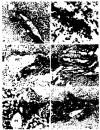Induction of DR/IA antigens in human liver allografts. An immunocytochemical and clinicopathologic analysis of twenty failed grafts
- PMID: 3904089
- PMCID: PMC3035980
- DOI: 10.1097/00007890-198511000-00007
Induction of DR/IA antigens in human liver allografts. An immunocytochemical and clinicopathologic analysis of twenty failed grafts
Abstract
Twenty failed human liver allograft specimens obtained at the time of retransplantation procedures were studied using a panel of monoclonal antibodies (T11, T4, T8, NK, B1, OKM1, OKM5, Ia, DR). A clinicopathologic analysis was used to distinguish between graft failures secondary to rejection (n = 10) and those due, at least in part, to other causes (n = 10). T lymphocytes constituted the major infiltrating cellular population in the liver in rejection cases, but significant numbers of B cells and monocytes/macrophages were present also. Following transplantation, but not before, the bile duct epithelium, as well as portal and central vein and hepatic artery endothelium expressed DR/Ia antigens. These structures are preferential targets of the rejection reaction. The selective destruction of bile ducts in livers undergoing rejection was manifested in these patients by striking elevations of serum gamma glutamyl transpeptidase (GGTP) activity, a marker of biliary epithelial damage. The induced expression of DR/Ia antigens on structures targeted for immune destruction may be an important event in the pathogenesis of liver allograft rejection.
Figures

Similar articles
-
Immunopathology of renal allograft rejection analyzed with monoclonal antibodies to mononuclear cell markers.Kidney Int. 1986 Mar;29(3):708-17. doi: 10.1038/ki.1986.56. Kidney Int. 1986. PMID: 2939279
-
Changes in the expression of major histocompatibility complex class II antigens in liver allograft rejection.J Pathol. 1990 Oct;162(2):165-71. doi: 10.1002/path.1711620210. J Pathol. 1990. PMID: 2250195
-
A quantitative analysis of T lymphocyte populations in human liver allografts undergoing rejection: the use of monoclonal antibodies and double immunolabeling.Hepatology. 1990 Dec;12(6):1305-13. doi: 10.1002/hep.1840120610. Hepatology. 1990. PMID: 1979551
-
Mechanisms in organ allograft rejection. An experimental and clinical study.Scand J Urol Nephrol Suppl. 1987;103:1-42. Scand J Urol Nephrol Suppl. 1987. PMID: 3321417 Review.
-
Analysis of intragraft effector mechanisms associated with human renal allograft rejection: immunohistological studies with monoclonal antibodies.Immunol Rev. 1984;77:61-84. doi: 10.1111/j.1600-065x.1984.tb00718.x. Immunol Rev. 1984. PMID: 6232203 Review.
Cited by
-
Early induction of MHC antigens in human liver grafts. An immunohistologic study.Am J Pathol. 1988 Oct;133(1):82-94. Am J Pathol. 1988. PMID: 3052095 Free PMC article.
-
Chronic rejection. A general overview of histopathology and pathophysiology with emphasis on liver, heart and intestinal allografts.Ann Transplant. 1997;2(2):27-44. Ann Transplant. 1997. PMID: 9869851 Free PMC article. Review. No abstract available.
-
ALLOREACTIVE T LYMPHOCYTES CULTURED FROM LIVER TRANSPLANT BIOPSIES: ASSOCIATIONS OF HLA SPECIFICITY WITH CLINICOPATHOLOGICAL FINDINGS.Clin Transplant. 1988;2(1):70-75. Clin Transplant. 1988. PMID: 21151800 Free PMC article.
-
Pathology of Chronic Rejection: An Overview of Common Findings and Observations About Pathogenic Mechanisms and Possible Prevention.Graft (Georget Tex). 1998 May;1(2):52-59. Graft (Georget Tex). 1998. PMID: 21566686 Free PMC article. No abstract available.
-
Inhibition of free radical generation and improved survival by protection of the hepatic microvascular endothelium by targeted erythrocytes in orthotopic rat liver transplantation.Transplantation. 1990 Jun;49(6):1055-9. doi: 10.1097/00007890-199006000-00006. Transplantation. 1990. PMID: 2163131 Free PMC article.
References
-
- Porter KA. Pathology of liver transplantation. Transplant Rev. 1969;2:129. - PubMed
-
- McLean IW, Nakane PK. Periodate-lysine-paraformaldehyde fixative: a new fixative for immunoelectron microscopy. J Histochem Cytochem. 1974;22:1077. - PubMed
-
- Hayry P. Intragraft events in allograft destruction. Transplantation. 1984;38:1. - PubMed
MeSH terms
Substances
Grants and funding
LinkOut - more resources
Full Text Sources
Medical
